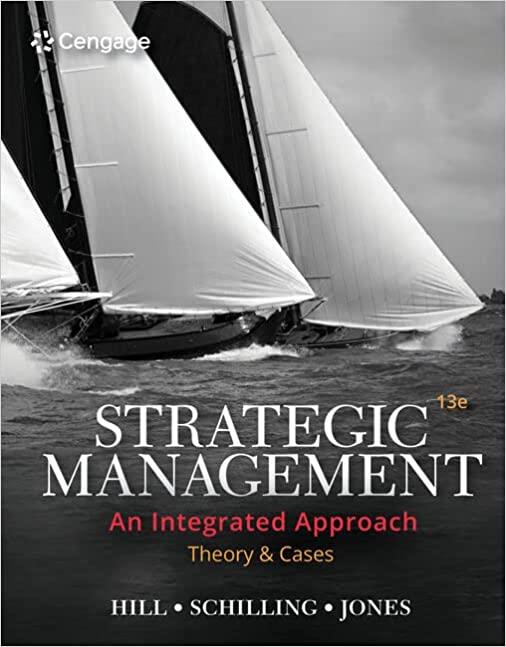In 1854, Louis Vuitton founded a trunk-making company in Paris. He had observed that most trunks could
Question:
In 1854, Louis Vuitton founded a trunk-making company in Paris. He had observed that most trunks could not be easily stacked because they had rounded tops; he thus began producing trunks with flat bottoms and tops out of trianon canvas, which was lightweight and airtight. The style became extremely popular, and soon competitors were imitating his design. To deter imitation, he began creating trunks with special patterns and a logo—creating the iconic look that distinguishes Louis Vuitton products today. After his death, his son, Georges Vuitton, took over the company and began to expand it worldwide. He exhibited the trunks at the Chicago World’s Fair in 1893, and toured cities such as New York, Chicago, and Philadelphia, selling the trunks to retailers. Over the next 80 years, Louis Vuitton stores opened all over the world, including Bombay (now Mumbai), London, Washington DC, Buenos Aires, Taipei, Tokyo, and Seoul. In 1987, Moët Hennessy and Louis Vuitton merged to create the LVMH group, one of the world’s largest and best-known luxury goods companies.
Many brands that came to be owned by the LVMH group were even older than Louis Vuitton:
Moët & Chandon, the champagne company, had been founded in 1743; Veuve Clicquot Ponsardin dated back to 1772; Hennessy (maker of fine cognac)
was originally formed in 1765, and perfumery Guerlain dated back to 1829. The oldest company in the group, Château d’Yquem, began making wine in 1593. Each company brought a legacy of craftsmanship and a loyal following of customers. However, LVMH’s biggest brand by far has continued to be the Louis Vuitton brand, which accounts for about one-third of its sales and almost half of its profit.
Much of LVMH’s growth into the diversified, luxury goods group that it has become can be attributed to Bernard Arnault. Arnault’s career in luxury goods began in 1984, when he bought Dior in the bankruptcy sale of an industrial group. A few years later, he bought Luis Vuitton, which at the time had 125 stores. He subsequently transformed the group into a luxury conglomerate with over 60 brands.
One of his first moves was to take production and distribution back from license-holders to begin restoring the exclusivity of the brands. In the years that followed, he bought Celine, Givenchy, Fendi, Kenzo, Bulgari, Sephora, Tag Heuer, and more.
In 2014, LVMH also opened a stunning new arts center in Paris, the Foundation Louis Vuitton. The center, designed by world-renowned architect Frank Gehry, generated a flurry of publicity for the group. Perhaps ironically, luxury goods benefit from economies of scale: A large luxury group can help a new brand grow faster through its distribution reach and expertise in brand management. “Key money” to open a shop on a prestigious, hightraffic location such as London’s Bond Street can cost as much as $16 million. On top of that, a vendor must pay to outfit the shop, and may pay annual rent of $1.5 million. A large luxury group can make such investments and wait for them to pay off; small brands usually cannot. Furthermore, large luxury groups have more bargaining power with fashion magazines, more access to important fashion shows, and more influence with “key opinion leaders.” They can also better attract and retain managers because they offer a deep, broad career path. At LVMH, for example, managers can move from fashion to wine to jewelry, and can live in a range of the world’s biggest cities, vastly increasing their experience and marketability.
According to Bain & Company, over the past 20 years, the number of luxury-goods consumers has more than tripled to 330 million, and their spending on luxury goods has risen at double the rate of global GDP. Most new buyers are not superwealthy but rather are “merely prosperous,”
earning up to $188,000 annually. As luxurygoods makers have raced to capture this market, they have had to carefully balance growth on a global scale while preserving an artisan image and exclusivity. Expanding too fast or too far can tarnish a luxury brand by making it seem too accessible.
By 2018, LVMH was earning almost €43 billion in revenues, hada net profit margin of 13.2%, andoperated 4,374 stores worldwide. LVMH had proven that a company could be big and global, yet have prestigious and exclusive brands. As noted by Arnault, “People said in 1989 that Louis Vuitton was already too big. Now it’s ten times the size.”
Questions
1. What are the key resources or competencies LVMH can leverage across its businesses?
2. Could those resources or competencies be shared via a market contract instead of common ownership?
3. What are potential sources of coordination costs or risks of LVMH’s diversification?
Step by Step Answer:

Strategic Management Theory And Cases An Integrated Approach
ISBN: 9780357033845
13th Edition
Authors: Charles W. L. Hill, Melissa A. Schilling, Gareth R. Jones





